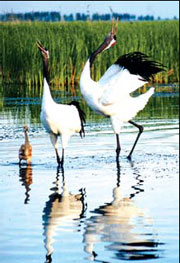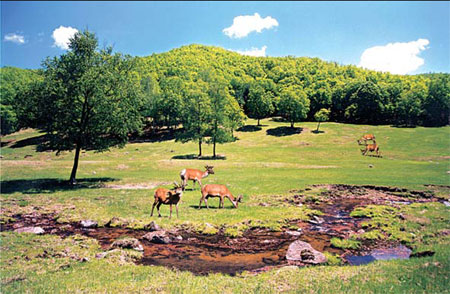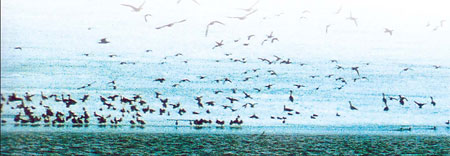International charm of Harbin
Updated: 2008-08-10 08:49
By Bian Yi(China Daily)
|
|||||||||||
|
Eco-friendly environment |
|
Home to wild cranes |
If Heilongjiang province in the extreme north of the country is likened to a swan poised to fly, the capital Harbin would be nestled just under its neck
Harbin is the birthplace of the Jin State, an ancient nation founded by the Nuzhen tribe, now known as the Manchu people.
Jin ruled half of China during Southern Song Dynasty (1127-1279) and ethnic Manchus founded the Qing Dynasty (1644-1911).
The city's name shows its roots - it means honor and reputation in Manchu.
Different from many historic cities on the central plains, which have splendid cultural heritage that sometimes confines them through norms and rules of tradition, Harbin, founded by nomadic tribes, has been more open.

More than 160,000 foreign nationals lived in the city at the end of the 19th century, bringing with them cultural currents and thoughts that blended with passing generations.
Central Avenue, known as the High Street of Harbin, has been witness to prosperity and wide cultural exchanges.
Even today preserved European-style buildings flank the sides of the famed avenue, providing a glimpse of what the city looked like then.
The 1,400-m-long avenue was home to foreign firms and stores, restaurants and hotels, dance halls and cinemas, cafes and bars built in Byzantine and Baroque architecture.
St Sophia Cathedral is another attraction in the city. For many Harbin locals, chorals in the church harken back to an earlier time.
The exotic atmosphere has resulted in Harbin's reputation as the "Oriental Paris".
Snowy world
In addition to its enchanting natural landscape, fertile soil, dense forests and abundant water, Harbin has a reputation of the "Ice City".
The city has a long winter that drops to 20 to 30 degrees below zero. Every family has a natural ice box in a wing of their houses for storing food.
No surprisingly, winter sports are quite popular in the city - as are artistic efforts with snow and ice.
Ice lanterns that came in to use in the early Qing Dynasty (1644-1911) have now developed from their original simplicity into a variety of elaborate artwork, including ice flowers, architecture and sculpture.
The annual Harbin Ice Lamp Party offers a collection of ice lantern art, "a fairytale that never repeats itself".
Sun Island
Sun Island, Harbin's pride, is a name familiar to many Chinese. The song "Beautiful Sun Island" quite popular in the early 1980s celebrated the beauty of the island.
Surrounded by clear blue water in summer, the island is covered in verdant plants, flowers, pristine landscape that is both quiet and wild.
About 300,000 trees and shrubs cover the island, including the Korean pine, Mongolian scotch pine, larch and spruce.
Winter brings its own enchantment in snow and ice. Sun Island recreational activities include skiing, ice sailing, skating and hockey.
The well-known Harbin Snow Sculpture Exposition and Ice Engraving Competition held every year presents wonders in ice and snow architecture.
About 20 man-made and natural scenic spots scattered around the island include Youth House, Sino-Japanese Friendship Garden and Sun Hill.
Jingpo Lake
Jingpo Lake is like a pearl inlaid in the northern border of China. Its natural beauty attracts increasing numbers of both domestic and foreign tourists.
The lake began to take shape about 10,000 years ago. After five volcanic eruptions, lava blocked the Mudan River to form a volcanic lake.
In the southeast of Heilongjiang, the largest lava dammed lake in China is a famous State-level tourist destination. Covering 95 sq km, the lake is 45 km long from south to north at a height of 350 m above sea level.
The north end of the lake flows over the lava dam and forms Diaoshuilou waterfall, 25 m high and 40 m wide. The pool at the bottom is dozens of meters deep.
Jingpo Lake is mentioned in historical materials, with its name changed in different dynasties. Its present name means its water is as clear and smooth as a mirror.
It winds in an S shape, surrounding small islands and with berths along its banks.
Touching local legends add to magic of the northern lake.
Sanjiang Wetlands
Jiamusi is a city in the inner Sanjiang - which means three rivers - Plain where the Heilong Wusuli and Songhua rivers converge. It faces Russia across the Heilong and Wusuli rivers along a 580-km border, so is known as the "First City in the Orient".
The easternmost city in China, Jiamusi is the third-largest city in Heilongjiang province after Harbin and Qiqihar.
Black and yellow rivers flow several dozen miles eastward from the confluence of the three rivers without mixing colors, creating a grand spectacle.
Diaoyutai, a scenic spot at the rivers' juncture, has boats shuttling across the green Heilong River.
The boundless snows of Sanjiang Plain provide tourists an amusement park for hunting, skiing and winter activities, as well as a panorama of golden wheat and rice in summer.
"Fish can not be called fish before running into sea. One can not say he has been to a Hezhe's home before tasting fried fish," goes a Jiamusi saying about the local ethnic group.
The Hezhe people are very hospitable, offering their "talaka" delicacy of fresh crucian carp that is cut into strips and soaked in vinegar until the fish turn white. Vinegar is strained away and minced garlic, coriander and other spices are added to cook a dish that is fresh and delicious, locals say.
Another specialty is "fish flake". Hezhe people peel off the skin of a fish when it just frozen, then cut it into flakes and eat it with salt and sauce.
Jiamusi is in the Sanjiang river basin where eight species of freshwater fish abound.
The best in the Heilong River is Chinese beluga, a big, strong long-lived fish that is rich in nutrition. It is excellent for all kinds of cuisine and used as a gift to friends and relatives.
Unique Hezhe fish skin clothes and boots, as well as ornaments made from ground fish bones, are famous souvenirs from Jiamusi.
|
Paradise for birds |
(China Daily 08/10/2008 page9)


